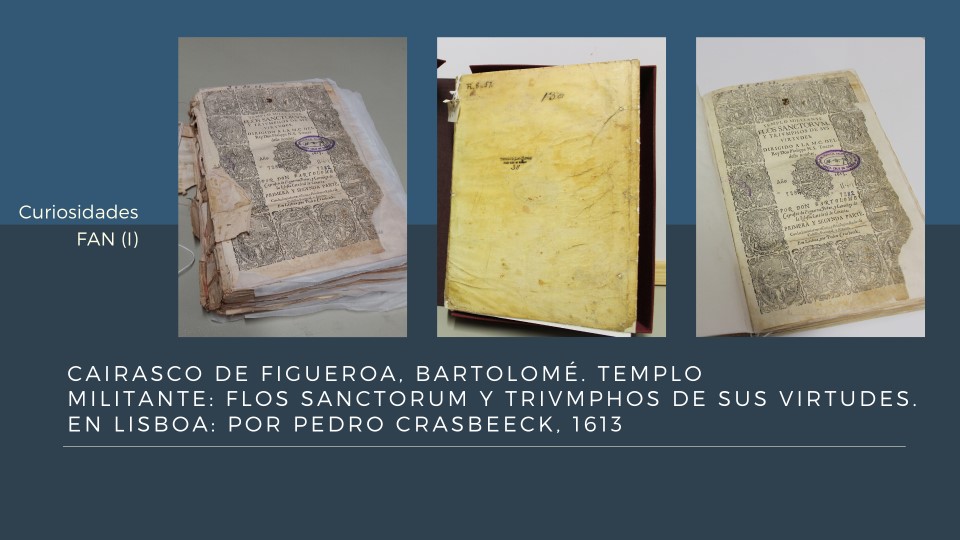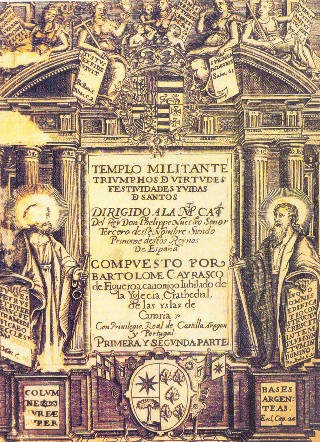Poeta, dramaturgo y músico canario incorporó en la literatura las características de la cultura canaria tras la conquista del archipiélago por parte de la Corona de Castilla........... Poet, playwright and musician from the Canary Islands incorporated into literature the characteristics of Canarian culture after the conquest of the archipelago by the Crown of Castile.

Resulta paradójico, cuando no dramático, que a falta de pocos años para que se celebren los cuatrocientos de su fallecimiento, el que hoy por hoy es reconocido casi por unanimidad como padre de las letras canarias, sea
prácticamente un desconocido para la sociedad canaria.
EL TEMPLO MILITANTE
(English at the end)
El cuarto centenario de la muerte de Bartolomé Cairasco de Figueroa (1610-2010), me ha brindado la oportunidad de escribir este libro sobre su obra principal Templo Militante o Flos Sanctorum. La edición consta de tres tomos y un DVD, con el siguiente contenido:
Tomo I: Introducción.
Tomo II: Primera y segunda parte de Templo Militante.
Tomo III: Tercera y cuarta parte de Templo Militante.
DVD: Facsímil completo de Templo Militante.
En la Introducción expongo los diversos temas tratados en Templo Militante, que el lector puede ver en el índice. Sugiero que se preste atención al fondo bíblico y teológico de este Santoral, que revela la sólida formación de Cairasco en estas materias. Es también evidente sus amplios conocimientos humanísticos en literatura, bellas artes, mitología, naturaleza y otras ciencias.
Pero Templo Militante nos abre las puertas para conocer, además, aspectos interesantes de la biografía del “canónigo canario”, como él mismo se define. Sus orígenes italianos, familia, canariedad, viajes, sentimientos, pensamiento, espíritu crítico y humor, están reflejados en su obra. Esta Introducción facilita la lectura siempre difícil de esta obra poética, escrita principalmente en octava rima.
Este primer tomo está enriquecido con ilustraciones, retratos o grabados, autógrafos de los más destacados personajes, escudos e inscripciones. Entre los autógrafos veremos los de Bartolomé Cairasco, los de sus padres Mateo y María, los de sus hermanos Serafín y Constantín y los de otros familiares. De especial interés consideramos las lápidas de la familia Castillo-Cairasco de la iglesia de Santo Domingo y los cuadros e imágenes de la ermita de Los Reyes, del patrocinio de la misma familia, el busto de Cairasco con sus detalles en la plaza homónima y los escudos de Figueroa y Argote de Molina de la Casa de Colón.
Concluye la Introducción con un apéndice documental, en el que reproducimos el poder otorgado a Bernardino de Palenzuela por Bartolomé Cairasco en 1603, conservado en el Archivo Histórico Provincial de Las Palmas, y la copia de su testamento que guarda el Archivo de la Catedral de Santa Ana.
En los tomos II y III se recoge gran parte de esta monumental obra titulada Templo Militante o Flos Sanctorum. He seleccionado los textos más significativos de los 207 capítulos que conforman sus cuatro partes, procurando salvaguardar el hilo argumental de cada una de las fiestas o vidas de los santos que se narran. Concretamente, de las 9.629 octavas reales escritas por Cairasco, se seleccionan 3.684. También se incluyen textos de los proemios de cada capítulo. Todo ello, acompañado de aparato crítico.
Las 1.603 notas a pie de página, ayudan a descubrir los secretos que esconden los versos del poeta, principalmente las citas implícitas de la Biblia y las fuentes literarias, históricas y doctrinales. En otras notas, se comentan, clarifican o corrigen frases, hechos o datos expresados por el autor. Las ilustraciones de estos dos tomos están tomadas de los grabados de la obra Vies des Saints ou Abrégé de L´Histoire des Pères, des Martyrs et autres Saints, editada en París en 1825. Como viene siendo habitual en mis publicaciones, la edición de los tres volúmenes ha estado al cuidado de don Carlos Gaviño de Franchy, cuya profesionalidad es bien conocida.
Finalmente, para que la obra fuese lo más dadivosa y útil posible, se incluye un DVD con el archivo digital del facsímil completo de Templo Militante, tomado de diversas ediciones. La primera y segunda parte de la edición de Luis Sánchez, Valladolid 1603. La tercera parte de la edición de Luis Sánchez, Madrid 1609. Y la cuarta parte de la edición de Pedro Crasbeeck, Lisboa 1615. Además de estos editores, en 1861 Agustín Millares Torres se propuso reeditar Templo Militante por entregas en el folletín titulado Omnibus, pero no llegó a culminar el proyecto al suspenderse la publicación.
No obstante, salió a la luz la primera parte y dos tercios de la segunda. Ahora, 400 años después de la muerte del poeta, he considerado que era el momento oportuno de publicar íntegra su obra fundamental en formato digital, con la intención de hacer un servicio a los lectores, principalmente a los investigadores, profesionales de la literatura, profesores y estudiantes.
Julio Sánchez Rodríguez.

The fourth centenary of the death of Bartolomé Cairasco de Figueroa (1610-2010) has given me the opportunity to write this book on his main work Templo Militante or Flos Sanctorum. The edition consists of three volumes and a DVD, with the following contents:
Volume I: Introduction.
Volume II: First and second parts of Templo Militante.
Volume III: Third and fourth parts of Templo Militante.
DVD: Complete facsimile of Templo Militante.
In the Introduction I set out the various topics covered in Templo Militante, which the reader can see in the table of contents. I suggest that attention be paid to the biblical and theological background of this Santoral, which reveals Cairasco’s solid training in these subjects. His extensive humanistic knowledge of literature, fine arts, mythology, nature and other sciences is also evident.
But Templo Militante also opens the door to interesting aspects of the biography of the «canon canario», as he defines himself. His Italian origins, his family, his Canary Islander nature, his travels, his feelings, his thoughts, his critical spirit and his humour are all reflected in his work. This introduction facilitates the always difficult reading of this poetic work, written mainly in octave rhyme.
This first volume is enriched with illustrations, portraits and engravings, autographs of the most important figures, coats of arms and inscriptions. Among the autographs are those of Bartolomé Cairasco, those of his parents Mateo and María, those of his brothers Serafín and Constantín and those of other family members.
Of special interest are the tombstones of the Castillo-Cairasco family in the church of Santo Domingo and the paintings and images in the chapel of Los Reyes, sponsored by the same family, the bust of Cairasco with its details in the square of the same name and the coats of arms of Figueroa and Argote de Molina in the Casa de Colón.
The Introduction concludes with a documentary appendix, in which we reproduce the power of attorney granted to Bernardino de Palenzuela by Bartolomé Cairasco in 1603, preserved in the Provincial Historical Archive of Las Palmas, and the copy of his will kept in the Archive of the Cathedral of Santa Ana.
Volumes II and III contain a large part of this monumental work entitled Templo Militante or Flos Sanctorum. I have selected the most significant texts from the 207 chapters that make up its four parts, trying to safeguard the storyline of each of the feasts or lives of the saints that are narrated. Specifically, of the 9,629 royal octaves written by Cairasco, 3,684 have been selected.
The texts of the proems of each chapter are also included. All of this is accompanied by a critical apparatus. The 1,603 footnotes help to discover the secrets hidden in the poet’s verses, mainly the implicit quotations from the Bible and the literary, historical and doctrinal sources. Other notes comment on, clarify or correct phrases, facts or data expressed by the author. The illustrations in these two volumes are taken from the engravings in the work Vies des Saints ou Abrégé de L’Histoire des Pères, des Martyrs et autres Saints, published in Paris in 1825.
As is customary in my publications, the editing of the three volumes has been entrusted to Don Carlos Gaviño de Franchy, whose professionalism is well known.
Finally, in order to make the work as generous and useful as possible, a DVD is included with the digital archive of the complete facsimile of Templo Militante, taken from various editions. The first and second parts of the edition by Luis Sánchez, Valladolid 1603.
The third part of the edition of Luis Sánchez, Madrid 1609. And the fourth part of the edition of Pedro Crasbeeck, Lisbon 1615. In addition to these publishers, in 1861 Agustín Millares Torres set out to republish Templo Militante in instalments in a pamphlet entitled Omnibus, but the project was not completed when publication was suspended.
Nevertheless, the first part and two-thirds of the second part were published. Now, 400 years after the poet’s death, I thought it was the right time to publish his fundamental work in full in digital format, with the intention of providing a service to readers, mainly researchers, literary professionals, teachers and students.
Julio Sánchez Rodríguez.
Translated with www.DeepL.com/Translator (free version)
